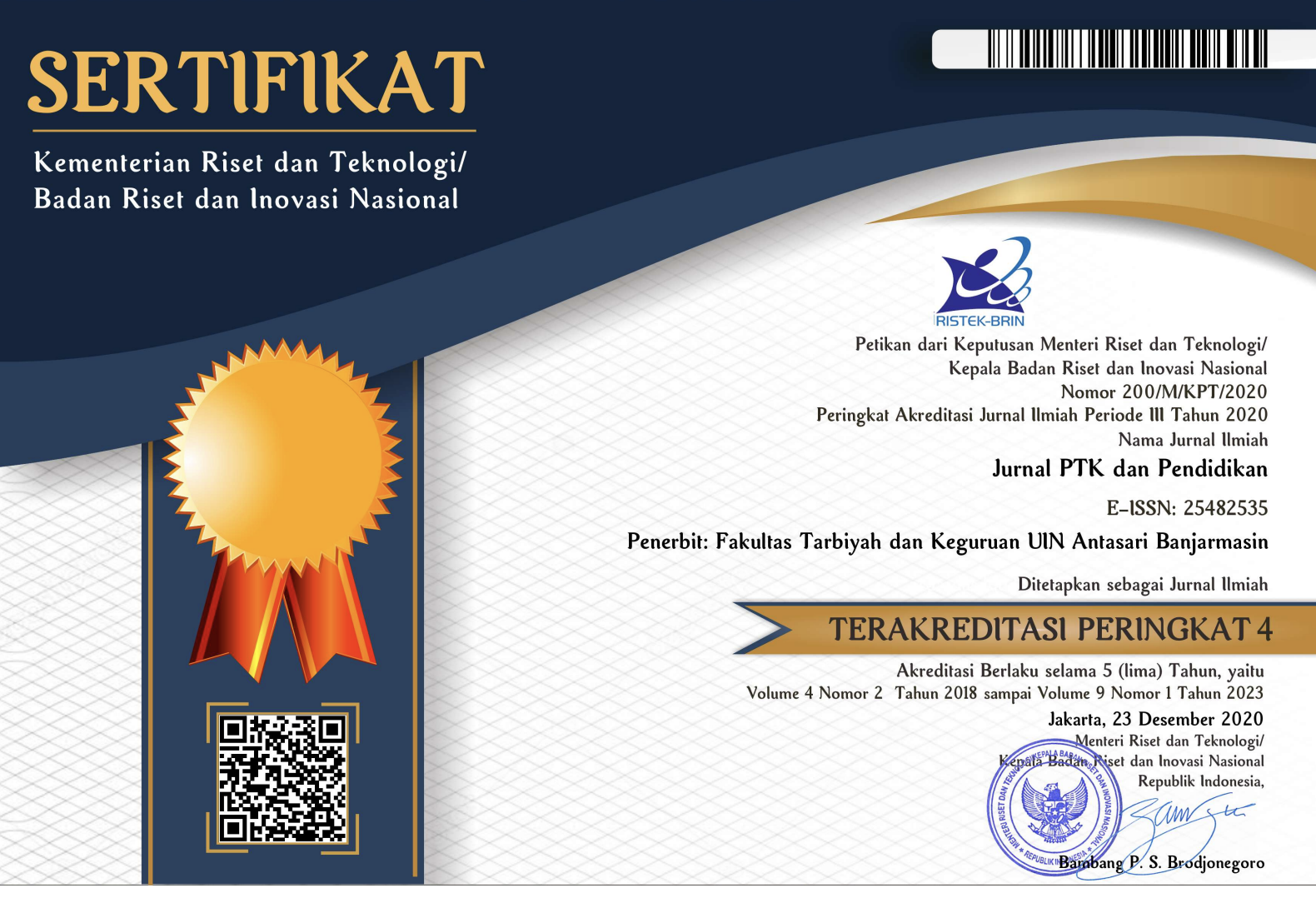Implementation of LRD (Listen, Read, Discuss) Strategy Learning for Increasing Reading Skill and Student Achievement on Discussion Text Material in Class XII IIK 3 Madrasah Aliyah Negeri 1 Banjarmasin Academic Year 2019/2020
DOI:
https://doi.org/10.18592/ptk.v5i2.3334Abstract
Has done research with the aim to increasing reading skill and student achievement on discussion text material through implementation of LRD strategy. This research design was used classroom action research which consisted two cycles with four phases; planning, action, evaluation and reflection. The subject were 37 students of class XII IIK-3 MAN 1 Banjarmasin. Data collection was used by test technique. Then, data were analyzed by quantitatively and qualitatively techniques. The research result showed that there was an increase in teacher’s activity from 31 at cycle I to 41 at cycle II, an increase in student’s activity from 23,50 at cycle I to 33 at cycle II, an increase in student’s achievement from 64,86 at cycle I to 83,91 at cycle II, an increase in student’s reading skill from 12,23 at cycle I to 15,73 at cycle II and student give good respon for learning which using LRD strategy.References
Ariyanti, P. (2015). Penerapan Strategi LRD untuk Meningkatkan Keaktifan dan Hasil Belajar Pada Mata Pelajaran Bahasa Inggris Di SMA Negeri 2 Surakarta Tahun Ajaran 2014/2015. Jurnal Pendidikan UNS. 4(1): 1-8.
Irma. (2015). Penerapan Strategi LRD untuk Meningkatkan Hasil Belajar Bahasa Indonesia Kelas V. Jurnal PGSD. 12(1): 22-23.
Iskandarwassid dan Dadang Suwendar. (2008). Strategi Pembelajaran Bahasa. Bandung: Remaja Rosdakarya.
Jayanti. (2016). The Use of Listen-Read-Discuss (L-D-R) Strategy to Improve reading Comprehension (Classroom Action Research of the Eighth Grade Students of SMP N 3 Salatiga in the Academic Year of 2015/2016. Graduating Paper STAIN Salatiga. 4(3): 89-90.
Kunandar. (2013). Penilaian Autentik (Penilaian Hasil Belajar Peserta Didik Berdasarkan Kurikulum 2013). Jakarta: Rajawali Press.
Manzo dan Rasinki, T.V. 2015. Listen-Read-Discuss: A Content Reading Heuristic. Journal of Reading. 2(8): 732-734.
Manzo, A.,V & Casela, U. P. (2008). Teaching Children to be Literate: A Reflective Approach. New York: Holt, Rinehart and Winston, Inc.
Nita, R. (2018). Keefektifan Strategi LRD Dalam Pembelajaran Membaca Pemahaman dan Hasil Belajar SIswa pada Siswa Kelas XI SMA Negeri 1 Tempel Yogyakarta. Journal of Education. 7(2): 90.
Pratiwi, Y. (2015). Pelaksanaan Strategi Listen, Read dan Discuss di Kelas X SMA Negeri 5 Surakarta Tahun Pelajaran 2014/2015. Jurnal Pendidikan UNS. 3(2): 50-58.
Purwanto. (2013). Evaluasi Hasil Belajar. Jakarta: Pustaka Pelajar.
Reniwati, P. (2017). The Effect of Using LRD (Listen, Read, Discuss) Strategy toward Reading Comprehension of the Second Year Students at State Junior High School 9 Tapung Kampar Regency. Journal Paper of UIN Riau. 9(2): 45-59.
Roberto, L. C. R. (2015). The Pros and Cons of Learning from the Teacher’s Standpoint. Journal of University Teaching & Learning Practice. 3(1) : 1-19.
Sudaryono. (2012). Dasar-Dasar Evaluasi Pembelajaran. Yogyakarta: Graha Ilmu.
Sudjana, N. (2014). Penilaian Hasil Proses Belajar Mengajar. Bandung: Remaja Rosdakarya.
Sudijono, A. (2014). Pengantar Statistik Pendidikan. Jakarta: Rajawali Pers.
Suharsimi, dkk. (2012). Penelitian Tindakan Kelas. Jakarta: Bumi Aksara.
Wu, H.,Y dan Hu, Ping. (2017). Major Factors Influencing Reading Comprehension. Sino-Us English Teaching Journal. 4(9): 14-19.
Downloads
Published
How to Cite
Issue
Section
License
- The right to publication of all journal material published on the Jurnal PTK dan Pendidikan website is held by the editorial board with the author's knowledge (moral rights remain the property of the author).
- The formal legal provisions for access to digital articles of this electronic journal are subject to the terms of the Creative Commons CC BY 4.0 DEED Attribution International (CC BY) license. This license enables reusers to distribute, remix, adapt, and build upon the material in any medium or format, so long as attribution is given to the creator. The license allows for commercial use.
- Printed and electronic published manuscripts are open access for educational, research and library purposes. In addition to these objectives, the editorial board shall not be liable for violations of copyright law.






